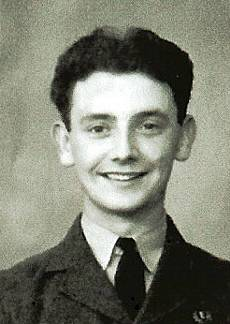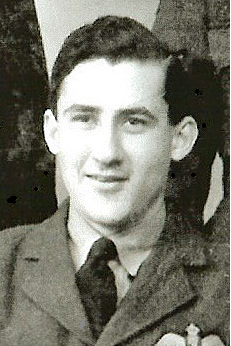RAF Crash Report
The following is an extract of crash report AIR 14/1442, ‘K’ report 203 purchased from the National Archive. This report was compiled by the Operational Research section of the RAF Bomber Command on 29 July 1944 following in an interview with the flight engineer Sgt H.D. (David) Davies who was the first of the crew to get home.
It is assumed that each aircraft crash was investigated in case a common fault was found that needed to be rectified during manufacture or maintenance of the aircraft. The report gave the official reason for the crash as “engine failure and possibly enemy action”. However Les and Doug did not fully agree with its contents but each of the crew may have had a unique view and opinion of the events of the night.

The aircraft took off from WICKENBY to attack VAIRES Marshalling Yards. It was a clear night and there was a half moon.
The Lancaster was now flying on the port inner engine only and height was lost to 7,000 feet in about 2 minutes. As the aircraft continued to lose height rapidly the Captain gave the order to abandon aircraft.
The Air Bomber, Navigator and Wireless Operator went from the front hatch and it is believed that the Rear and Mid Upper gunners left safely from the entrance door.
After the Wireless Operator had left the Flight Engineer un-feathered the starboard outer engine so that there was a better chance of the aircraft remaining steady while the Pilot left. He then left at once from the front hatch making a successful exit. He noticed before leaving that one of the petrol tanks (he does not remember which) had lost about 50 gallons of petrol.
While descending on his parachute he noticed that the Pilot had left the aircraft and was coming down safely on his parachute. He landed safely in open country at about 03:40 hours.
After all the crew had left the aircraft, it caught fire, the starboard wing dropped and it swung off to starboard. It hit the ground and then exploded and continued to burn on the ground for some time.
The informant was not conscious of the aircraft having been damaged by enemy action, but he thinks it must have been hit at some time prior to the failure of the port outer and starboard inner engines – especially as he noticed that some fuel had been lost from one of the tanks. He does not think that the Pilot deliberately altered course after bombing, but it seems likely that the aircraft swung to starboard as the informant is believed to have landed in the south western outskirts of Paris.
Mike Guilfoyle’s Account
Below is Mike Guilfoyle’s detailed account of ND424’s final mission on 28 June 1944. This was sent to me by Mike’s son John Guilfoyle in June 2012. It was written by Mike in later life and provides a different perspective.

The bomber squadron had two consecutive 100% night raids, where all the planes on the squadron were on the raid and returned safely. So the Group Captain O/C decreed that a record would be created in having a third consecutive night.
There was one snag though. The Idiot’s plane, G for George, was in the hanger on a major maintenance just commenced. But the Group Captain ordered the engineers to complete the job in time for the take-off, regardless. He also ordered the bomb squad to load the goodies onto the plane while in the hanger! The jobs were completed in the dark, and towed out just as the crew arrived for take-off. KR&Rs (Kings Rules & Regulations), the Bible of the services, stated that before an aircraft could be returned to operations, it had to be flight tested. This was ignored.
Halfway across the channel we feathered the first engine due to high coolant temperature. The crew, including a Jewish Canadian navigator, being young and very keen, decided to continue to the target, which was only to Paris railway sidings on the eastern suburbs. There were lots of tanks and other armaments on the long freight train, and we were to destroy them. So on we pressed with the target in sight.
The second quit through low oil pressure caused by the oil leaking away. Really, the only thing to do was bomb on two engines, which we did. Luckily we were bombing at eight thousand feet so we kept height once the bombs were dropped.
But horror of horrors! The third one went as we turned away from the target, coolant again. The flight engineer kept on saying increasingly louder “feather her, skipper, we are about to catch fire”. So we did a trade. Start the one with low oil pressure and we will get away from Paris on two”. But of course in a few minutes, enough distance to leave the city built-up area, the engine began to show great distress, so we feathered.
Meanwhile the navigator was calculating how far we would be when we reached two hundred feet. On one engine we could maintain that height, and if there was no hill higher between us and the coast, we might then make Manston emergency aerodrome and land OK. Unfortunately, there were some hills over four hundred feet near the coast, and of course we would be at two hundred feet long before.
Reluctantly I gave the order to bail out. We were then at around four thousand feet, and descending at four hundred feet per minute. and all except the flight engineer were soon gone. Taffy, bless his heart, said that as I could not bail out successfully because as soon as I left the pilot’s seat the plane would start spinning, I would stand a better chance of survival if we crashed landed. On a black night there was no way I was going to try it.
We argued for what seemed to me too long. I then pulled rank and ordered him to jump, sweetening the order by telling him if he did not jump immediately, then I would and he could crash land himself. He saluted, wished me well, went down the hatch and jumped out of the bomb-aimers exit in the nose forward and below me.
Now the fun really began, for as I trimmed the plane as well as possible, she started to drop the wing and commence to turn. Racing down the steps I found the hatch back over the exit. Trying to move it was impossible, but I saw that there was a big enough slit in between the cover and aft of the exit frame. Hurriedly I flew back up, righted the old girl, then pointed the other wing tip about 60 degrees to the ground.
No sooner that I got the degrees on the artificial horizon, and saw her going through three thousand feet, than my knees were hanging under the slit, and kicking it up as hard as I could. But once more I had to race up to repeat the wing tip trick. Not even stopping to check the altitude, I found my feet swinging in the air, and the cover free. So was I a micro-second later.
We were trained to count to ten, like ten seconds to get away from the plane, before pulling the ripcord. I counted a quick one, two, three and pulled, and like a “cockeyed optimist” watched G for George slowly begin her death spin. I have never felt so lonely in my life either before or after. She exploded on hitting the ground about a minute later, being night made a good fireworks display.
Then I noticed that I was going backwards, so tried to spin the chute around as we were told to do in the three hour training session. I pulled three times without a budge from the backward drift. Then unexpectedly, I was in a pine tree, more like a sapling, because it gently bore me to the ground! Some would call it luck, but like you I called it the natural happening to a “cockeyed optimist”.
Just to clarify why the exit was closed. The bomb aimer had not obeyed the correct drill and thrown the cover through the opening before jumping. He had instead thrown it forward over the bomb sight. Taffy would not have noticed, either because up until he left, the wings were level.
